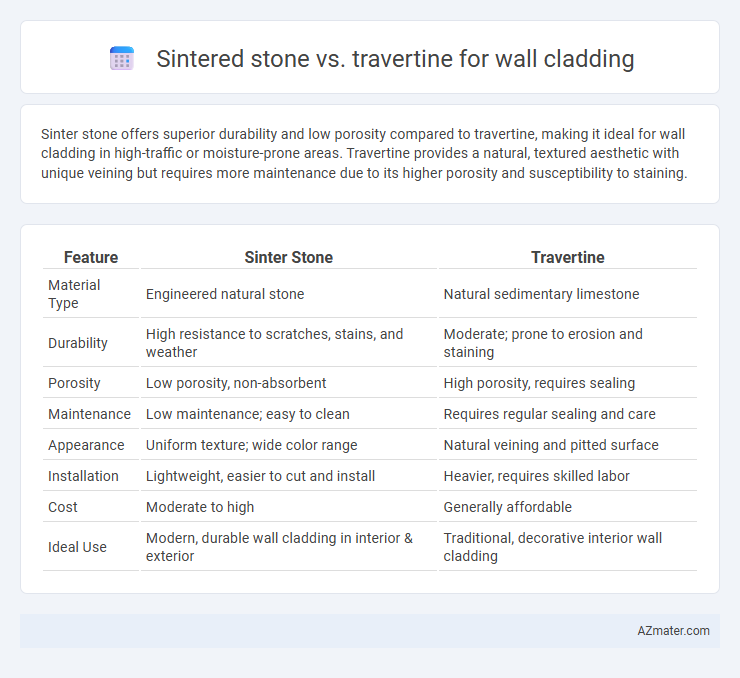Sinter stone offers superior durability and low porosity compared to travertine, making it ideal for wall cladding in high-traffic or moisture-prone areas. Travertine provides a natural, textured aesthetic with unique veining but requires more maintenance due to its higher porosity and susceptibility to staining.
Table of Comparison
| Feature | Sinter Stone | Travertine |
|---|---|---|
| Material Type | Engineered natural stone | Natural sedimentary limestone |
| Durability | High resistance to scratches, stains, and weather | Moderate; prone to erosion and staining |
| Porosity | Low porosity, non-absorbent | High porosity, requires sealing |
| Maintenance | Low maintenance; easy to clean | Requires regular sealing and care |
| Appearance | Uniform texture; wide color range | Natural veining and pitted surface |
| Installation | Lightweight, easier to cut and install | Heavier, requires skilled labor |
| Cost | Moderate to high | Generally affordable |
| Ideal Use | Modern, durable wall cladding in interior & exterior | Traditional, decorative interior wall cladding |
Understanding Sinter Stone: Composition and Properties
Sinter stone, composed primarily of finely ground natural minerals fused under high heat and pressure, offers exceptional density and durability compared to traditional materials like travertine. Its non-porous surface provides superior resistance to stains and weathering, making it ideal for exterior wall cladding applications. The compact structure of sinter stone ensures low maintenance and enhanced structural integrity, distinguishing it from the more porous and softer travertine.
What is Travertine? Key Features and Characteristics
Travertine is a natural sedimentary stone formed by mineral deposits from hot springs, characterized by its porous texture and warm, earthy tones ranging from cream to reddish-brown. Key features include its durability, unique veining patterns, and natural pitted surface that can be honed or filled for a smooth finish, making it ideal for elegant wall cladding. This stone's natural insulation properties and ability to age gracefully add both functional and aesthetic value to interior and exterior wall applications.
Aesthetic Appeal: Sinter Stone vs Travertine
Sinter stone offers a sleek, contemporary aesthetic with uniform textures and a wide range of customizable colors, making it ideal for modern wall cladding designs. Travertine provides a natural, rustic charm with its distinctive porous surface and earthy tones, adding warmth and timeless elegance to spaces. The choice between sinter stone and travertine depends on whether a polished, minimalist look or a textured, organic feel is desired for wall cladding projects.
Durability and Longevity Comparison
Sinter stone offers superior durability for wall cladding due to its dense, non-porous structure that resists stains, scratches, and weathering better than travertine. Travertine, a natural limestone, is more porous and prone to erosion and discoloration over time, requiring regular sealing to maintain its appearance. For long-term longevity, sinter stone's engineered composition makes it a more resilient and low-maintenance choice compared to the softer, more vulnerable travertine surfaces.
Maintenance Requirements: Sinter Stone vs Travertine
Sinter stone offers significantly lower maintenance requirements compared to travertine, as its non-porous surface resists staining, mold, and moisture buildup, reducing the need for frequent sealing. Travertine, a natural limestone, requires regular sealing to prevent absorption of water and dirt, making it more susceptible to staining and surface erosion over time. For wall cladding, sinter stone's durability and ease of cleaning provide a more practical and cost-effective solution in environments exposed to humidity or pollution.
Installation Process and Practical Considerations
Sinter stone offers a more streamlined installation process for wall cladding due to its precise manufacturing and lightweight structure, reducing labor time and minimizing structural support requirements. Travertine demands careful handling and skilled craftsmanship during installation because of its porous nature and heavier weight, necessitating proper sealing and reinforcement to prevent damage and ensure durability. Practical considerations favor sinter stone in high-moisture environments for its resistance to staining and erosion, while travertine provides a natural, textured aesthetic but requires ongoing maintenance to preserve its appearance on walls.
Cost Analysis: Initial Investment and Long-Term Value
Sinter stone generally demands a higher initial investment compared to travertine due to its advanced manufacturing process and durability. Travertine offers a more cost-effective upfront price but may require more frequent maintenance and sealing over time, increasing long-term expenses. Evaluating durability and maintenance needs reveals sinter stone's superior long-term value for wall cladding projects seeking longevity and reduced upkeep.
Environmental Impact and Sustainability
Sinter stone exhibits lower environmental impact compared to travertine due to its manufacturing process, which often uses recycled materials and requires less quarrying, reducing habitat disruption. Travertine extraction involves extensive mining that contributes to landscape alteration and higher carbon emissions, making it less sustainable for wall cladding. Sinter stone's durability and low maintenance extend its lifespan, enhancing its sustainability profile for eco-friendly building projects.
Applications and Versatility in Wall Cladding
Sinter stone offers exceptional durability and resistance to weathering, making it ideal for exterior wall cladding in both residential and commercial buildings, while travertine is favored for its natural, warm aesthetic in interior wall applications such as feature walls and bathrooms. The versatility of sinter stone includes customization in thickness and color, allowing for a modern, sleek appearance on facades, whereas travertine provides a classic, textured look suitable for traditional and rustic designs. Both materials are compatible with various installation methods, but sinter stone's low porosity enhances performance in high-traffic or moisture-prone areas compared to the more porous travertine.
Which is Better for Wall Cladding: Sinter Stone or Travertine?
Sinter stone offers superior durability and stain resistance compared to travertine, making it ideal for high-traffic or moisture-prone wall cladding areas. Travertine provides a classic, natural aesthetic with unique porous textures but requires regular sealing and maintenance to prevent damage. For long-lasting, low-maintenance wall cladding, sinter stone is generally the better choice, while travertine suits applications prioritizing natural elegance.

Infographic: Sinter stone vs Travertine for Wall cladding
 azmater.com
azmater.com